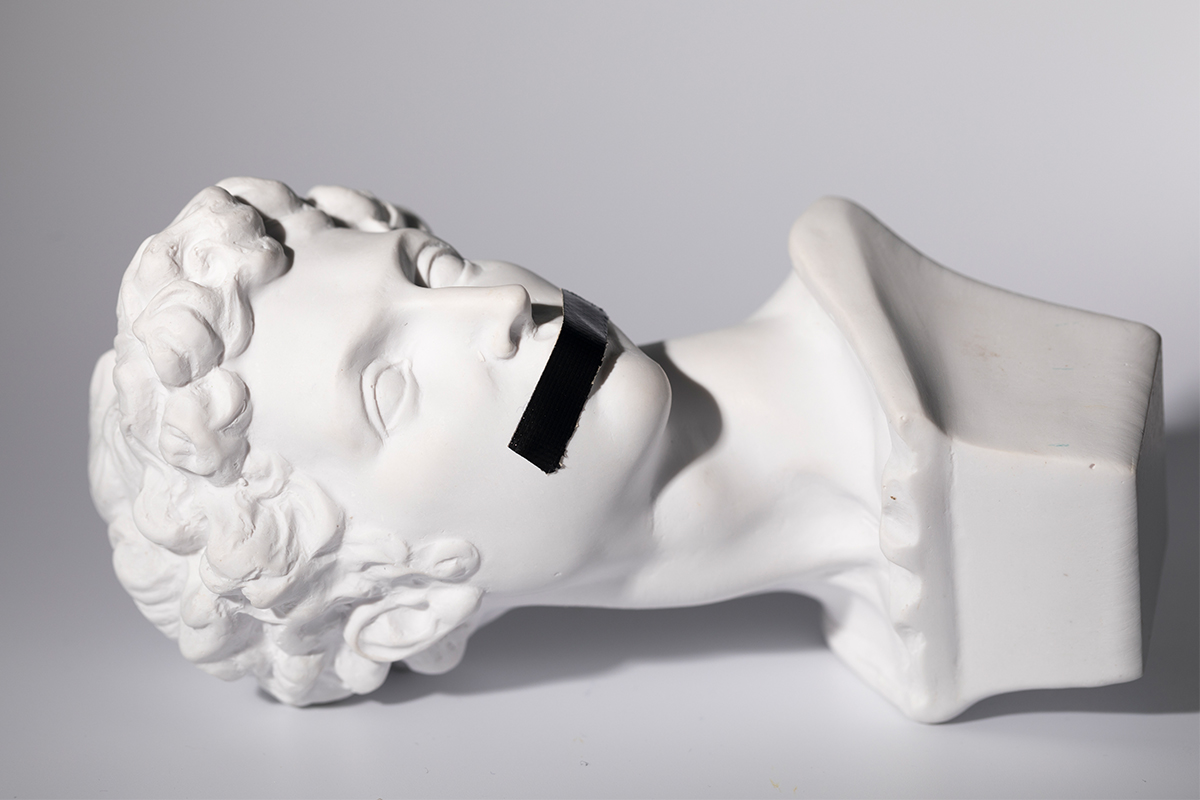These days, “mouth breather” is still a disparaging term, slang for a stupid person. It’s the sort of anachronistic cheap shot you usually hear from a self-serious Little League coach or an uncle who also likes to tell his nephews to get haircuts. But historically, the phrase had medical meaning. It was used in the early 1900s, primarily to describe children who had to breathe through their mouths, instead of their noses, due to underlying medical conditions like adenoid hypertrophy, enlarged tonsils or a deviated septum.
While the term may have been co-opted for name-calling purposes, the general thesis — that mouth breathing generally isn’t a great idea — has held true all the while. In fact, humans have been on that beat for thousands of years. Ruminations on proper breathwork have been around since 400 BC, when Taoist Chinese philosophers encouraged young scholars to improve their quality of life by “nourishing their breaths.” In the 1830s, meanwhile, American painter George Catlin observed that Native Americans of the Great Plains taught babies to breathe through their noses instead of their mouths. And in the 1950s, outré cross country coaches had their athletes run laps with water in their mouths, in an attempt to prioritize the nasal passageway during races.
Still, mouth breathing isn’t the exclusive domain of children, or people with health issues. Surveys have indicated that well over half of Americans breathe through their mouths every day. In many cases the practice is pure habit, an unconscious lifestyle choice, which is too often reinforced by a few rounds with a bad cold, or a half hour of vigorous exercise. People don’t know the history, let alone the science, and have no clue that there’s another way. That’s why science journalist James Nestor wrote the book Breath: The New Science of a Lost Art. It became a New York Times Bestseller, and is highly recommended by breathing deity Wim Hof.
The 10 Best Breathing Exercises for Sleep, Fitness and Calm
There are a lot of tricks out there. Keep these in your toolkit.Mouth Breathing = Bad
After years of reporting for Outside, Men’s Journal and Scientific American, Nestor was well-quipped to write Breath. The book took him four years to complete, and it included one crucial experiment that involved a team of Stanford University scientists blocking his nose with tape and silicone for a week and a half. As Nestor told CNN: “We knew it wasn’t going to be good, because there’s a very firm scientific foundation showing all the deleterious effects of mouth breathing, from periodontal disease to metabolic disorders.”
Nestor’s health completely fell apart. His blood pressure rose 13 points, his pulse went up, his blood oxygen dropped. On a broad scale, that reaction tracks with our understanding of the perils of neglecting the nose. When we breathe through the nose, the nasal passageway humidifies and pressurizes the air. It produces nitric oxide, an anti-everything (antifungal, antiviral, antiparasitic and antibacterial) molecule that “screens” air particles before they make it to the lungs. Once there, the lungs have an easier, more efficient time of circulating oxygen throughout the body. One easy way to picture it: the Magic School Bus would have a much shorter adventure heading to the lungs through the mouth, than through the nose.
But not even Nestor could have have predicted the extreme toll that 10 days of forced mouth breathing would inflict on his body, particularly his sleep. He began snoring for hours each night, essentially developing sleep apnea overnight. Constant mouth breathing through the day leads to constant mouth breathing at night, which leads to snoring, sleep apnea, hypopnea, sleep deprivation and daytime fatigue. It’s a brutal, self-referential cycle. The nose is always compromised when we lie down; its blood vessels swell and constrict whenever we press our head against a pillow. But while breathing through the mouth feels like a solution, it actually exacerbates the situation.
Mouth breathing triggers more nights with clogged nasal passageways, which triggers … more mouth breathing. If you don’t have a partner who’s told you for years that you snore like a freight train, tell-tale symptoms of nightly mouth breathing include mouth dryness, bad breath, brain fog and even multiple bathroom trips per night. (Breathing abnormalities have been shown to increase urine production.) Nestor’s obvious, short-term fix while researching his book was to simply have the Stanford scientists remove the tape from his nose. But fascinatingly, his long-term fix — part of the reason he wrote this book was a personal mouth breathing habit — involved adding tape to his mouth.
Why Learning to Control Your Breath Will Change Your Life
It’s the only autonomic operation we can influence. Here’s how to get started.The Tape Fix?
Nestor now advocates that people affix a small piece of tape to the center of their lips before going to sleep. Perhaps aware of previous criticism of the practice, mostly from sleep experts wary that an everyday adhesive could close a crucial passageway, Nestor recommends porous, hypoallergenic tape. He says: “You are not hermetically sealing your mouth off, the point is just to train your mouth to stay shut when you’re unconscious. People will be amazed by this simple, free hack, what it does for the quality of your sleep and the quality of your health. I adopted it, and it was dramatic.”
While Nestor prefers to pick up a roll of micropore tape at the corner store for a $1, and apply a sliver to the center of his mouth, there now exist performance-grade sleeping strips, from brands like SomniFix and Snorless. SomniFix, in fact, received an investment of $500 million from Mark Cuban last year on Shark Tank. They aren’t for people with serious medical concerns; if you have severe nasal breathing problems, are obese, struggle with heart health, or have low blood pressure, you shouldn’t use one. There are temporary concerns, too; sleep strips aren’t meant to be used when you’re legitimately sick, or going to bed drunk. The body needs all the breathing routes it has, mouth breathing be damned for the night.
Other concerns with sleep strips, be they Nestor’s DIY drugstore method or those from SomniFix (which, by the way, will set you back $20 for a monthly pack) are more immaterial, but still relevant. Having a piece of tape on your mouth is uncomfortable when you’re trying to fall asleep. Similar to wearing a retainer or sleep mask, it’s likely you may abort the apparatus after an hour of laying in the dark, as the daunting prospect of insomnia becomes a more pressing worry than following through on something you read about. The strips can also leave trace amounts of adhesive, which may aggravate your skin or lips.
How to Get Started
Ultimately, taping your mouth for sleep should perhaps not be considered a fail-safe life hack, but a menu option to those (most of us) who mouth breathe as a way of habit. It’s a reminder that doing an endless Napoleon Dynamite impression, during the day or night, is a fast track to a variety of health issues. Nestor points out that we unfortunately can’t directly control crucial organs in the body, like the stomach or kidneys. But we can influence them. We can make their daily tasks easier by breathing with positive intent. If you’re not ready, or just too dubious, to shut off your mouth before bed, start by reconsidering about how you take in air during the day.
On average, human beings breath 20,000 times a day, nearly nine million times a year. You’ll have ample opportunity to reassess. There’s a reason doctors agree we were designed to breath through our noses from birth. There’s a reason Nestor’s book is full of crazy examples of people managing to do remarkable things once they harnessed their breathing — from a German teacher conquering scoliosis to Olympians defeating a field of runners who were all using supplemental oxygen. Breathing through the nose is a game changer….especially in an era of airborne viruses.
Multiple studies and trials examined the relationship between nitric oxide and COVID-19 a few years back, and one actually concluded: “[Nasal breathing is a] lifestyle change … that may also help to reduce SARS-CoV-2 viral load and symptoms of COVID-19 pneumonia by promoting more efficient antiviral defense mechanisms in the respiratory tract.” That’s a big deal. And you can get started now. Take a deep breath in through your nose for 5.5 seconds (Nestor’s preferred duration), hold it, then exhale. Repeat that. Practice. It will seem like a hassle at first, perhaps for a while. Can’t anything remain on auto-pilot at a time when there’s already so much to think about? But it shouldn’t be enough to just breathe easier in 2023. We all deserve to breathe better.
The Charge will help you move better, think clearer and stay in the game longer. Subscribe to our wellness newsletter today.


























